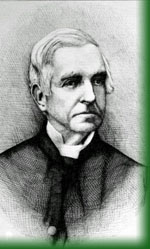
Thomas Brock Fuller's
Early Years
On Niagara Becoming
an Anglican Diocese
T. B. Fuller Becomes
First Bishop of Niagara
From
The Bishops of the Church of England in Canada and Newfoundland
by
Charles Henry Mockridge
published in 1896
Niagara Becoming an Anglican Diocese


Archdeacon Fuller had always a great desire to see the Niagara district formed into a separate diocese.
It was his wife's home, and had been his own for many years.
It possessed many attractions, the climate being much milder than other parts of Canada, so much so that tender fruits, such as grapes and peaches, grew in enormous quantities; its scenery was magnificent, especially in the vicinity of the great cataract, the spray of which could be seen from a great distance and its roar of foaming waters heard for many miles.
Ecclesiastically, it was connected with some of the earliest scenes in the history of Upper Canada.
Old Fort Niagara still stands to remind the passer-by of the days of early strife, when the colony itself was still a wilderness.
Here, at Niagara-on-the-Lake, then called Newark, the first Parliament of Upper Canada was held by Governor Simcoe in September 1792, in a small frame house built for the purpose.
Here lived one of the earliest clergymen, of the province,
Rev. Robert Addison, who received the support and encouragement of Col. Butler and his rangers.
The burying ground of the old St. Mark's Church still has tombstones scarred by wanton soldiers in the war of 1812.
Brock's monument overlooks the scene of the great battle which saved Canada to the British Crown, and made historic the vicinity of Queenston Heights.
Grimsby, too, in the midst of a beautiful fruit country, possessed a church since the beginning of the century; and Ancaster, close to the lovely Dundas valley, had church services established as early as the year 1818.
Chippawa, almost within sound of the great foaming waters, had services early established there, and through the munificence of T. C. Street. Esq., was endowed to the extent of $12,000.
The whole district, including the large County of Wellington, had become thickly populated and prosperous.
Three of the early towns had become cities, viz., Hamilton, St. Catharines, and Guelph.
Parishes had multiplied everywhere, until they seemed fairly to demand that they should be formed into a separate diocese.
Then it was that Mrs. Fuller and her sister, Mrs. O. T. Macklem, offered $15,000 towards the commencement of an endowment for a new diocese, which they desired should be called by the name "Niagara," the name that had been familiar to them from childhood. This led to other subscriptions mostly, it would seem, "promises to pay," but sufficient to warrant, as it was thought, the formation of a new diocese.
The House of Bishops was satisfied with the assurances given regarding the endowment of the see, and the diocese was formed, consisting of six counties, viz., Haldimand and Welland, on Lake Erie; Lincoln, on the Niagara River; Wentworth and Halton, on Lake Ontario; and Wellington, lying inland, and west of Halton. These contained a Church population of nearly fifty thousand souls, and, in all, fifty-six clergymen.
Next Page - Thomas Brock Fuller Becomes First Bishop of Niagara
Then it was that Mrs. Fuller and her sister, Mrs. O. T. Macklem, offered $15,000 towards the commencement of an endowment for a new diocese, which they desired should be called by the name "Niagara," the name that had been familiar to them from childhood. This led to other subscriptions mostly, it would seem, "promises to pay," but sufficient to warrant, as it was thought, the formation of a new diocese.
The House of Bishops was satisfied with the assurances given regarding the endowment of the see, and the diocese was formed, consisting of six counties, viz., Haldimand and Welland, on Lake Erie; Lincoln, on the Niagara River; Wentworth and Halton, on Lake Ontario; and Wellington, lying inland, and west of Halton. These contained a Church population of nearly fifty thousand souls, and, in all, fifty-six clergymen.
Next Page - Thomas Brock Fuller Becomes First Bishop of Niagara
